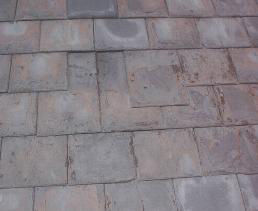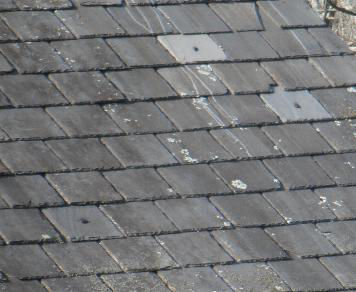

Slate Roofs by Bill Kibbel
In my experience, having an older slate roof evaluated by general roofing contractors, consultants or inspectors frequently results in incomplete, incorrect or in some cases, intentionally misleading advice. This often leads to non-professional and temporary repairs, costly unnecessary repairs or replacement of a roof that still has many decades of remaining life. I've evaluated some unfairly condemned roofs that could likely last

another century. If you're in a panic about a leak or some broken or missing slates, it's easy to go with the first assessment without further opinions or research.
Unfortunately, many roofing contractors seem to have a single mission - sell complete new roof systems. Combined with lack of knowledge about slate roofs it's not too difficult to steer customers to their standard and familiar product of asphalt shingles. Other contractors may offer cheaper solutions to correct leaks if presented with a limited budget. Here again, lack of knowledge abounds and perpetual inappropriate repairs seem to plague many slate roofs. While it's wise to get an unbiased opinion about major components of a building, there seems to be much misinformation and even folklore spread by many professional consultants and inspectors about slate roof systems. This results in condemnation of roof systems that may only need typical repairs and some maintenance.
All slate roofs, no matter the age, require regular repairs. As the roof ages, the frequency or amount of the repairs may increase. The most important factor is finding the right person, with the right knowledge, skills and tools to make those repairs.
Cracked, broken, loose or missing slates need to be replaced regularly. If a half dozen or less need replacement every year, I'd consider it a typical older roof in pretty good condition. In the

colder regions, early Spring is the usual time to find the most significant wear. Heavy snow cover sliding down and expanding ice will crack, break and loosen slates.
By far, the most common repairs I find are also the worst. This includes using roofing cement, mastic, adhesive, caulking and even spray-on coatings to patch gaps that are left exposed when slates have broken or fallen off. Not only is this only a temporary repair, it makes it quite difficult to re-repair it properly. In addition, the person making the repairs is likely the type that just walks over slate roofs causing small cracks in individual slates that will quickly expand. Sometimes this

damage is more extensive than the original issue. Knowledgeable slate repair technicians will only work off ladders placed on the roof that are hooked to the ridge, or on platforms supported by roof jacks nailed to the rafters.
Replacing individual damaged or missing slates is the accepted repair. Using the proper method to remove the old and fasten the new slate is also very important. Removing the broken remaining piece of slate is done with a “slate ripper” tool. This slides up under the slate and extracts the concealed nails still in place. Forcing a new slate over old or broken nails is likely just going to damage the new piece.
The technique used to fasten the new replacement slate is also important. Too many slate roofs have the replacements secured by “face nailing”. This involves punching a hole through the exposed section of a perfectly good new slate, driving a nail through the hole to secure it and smearing some temporary goop over the nail. There's no way I can count the number of roofs I've seen that look like they contracted some type of pox.

The knowledgeable slate roofer can secure replacement slates with nails that are completely concealed. Another accepted method is to secure the new slate with a thick-gauge wire hook, however a portion of each hook will be visible. Some hooks however are only thin-gauge sheet metal, often soft copper, that are not rigid enough, unbend and release the replacement slate.
It's also important that each replacement slate is very close to the thickness as the rest. The wrong thickness can kick up the slate at adjoining courses, which can then easily break.
Some other issues with slate roofs that can cause ongoing serious leaks are from improper installation. The most common is the improper overlap of slates at courses (headlap). Another is not properly setting the nails that secure each slate. This usually results in the nails protruding up and breaking off or popping holes through the slates in the course above above.

Metal flashings, used to line valleys, seal where roofs meet walls, chimneys and penetrations, can need repair or replacement as the metal doesn't last as long as the stone roof. Fortunately, a competent repair contractor can carefully remove and replace these flashings without tearing off an entire roof. Patching with troweled-on goop is not a professional or permanent repair.

Bill Kibbel is a consultant and an inspector of historic homes
& commercial buildings at Heritage Building Inspections.
Website was started with Mobirise website templates